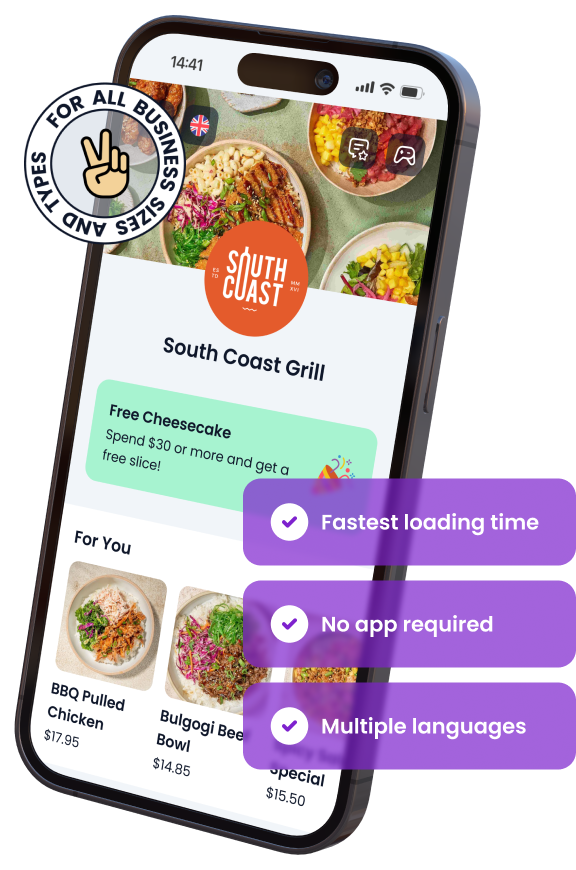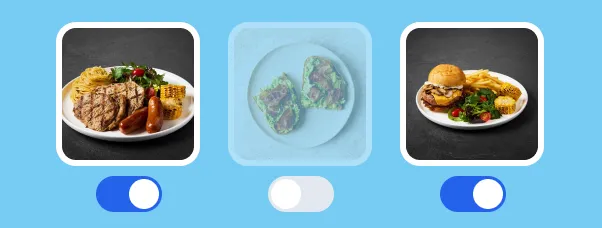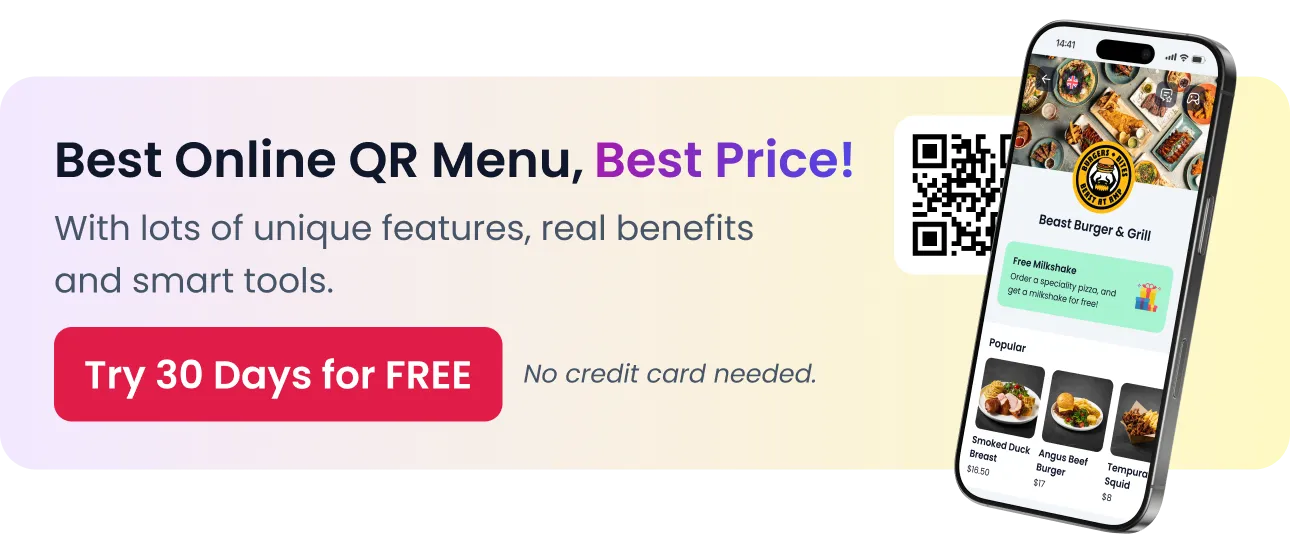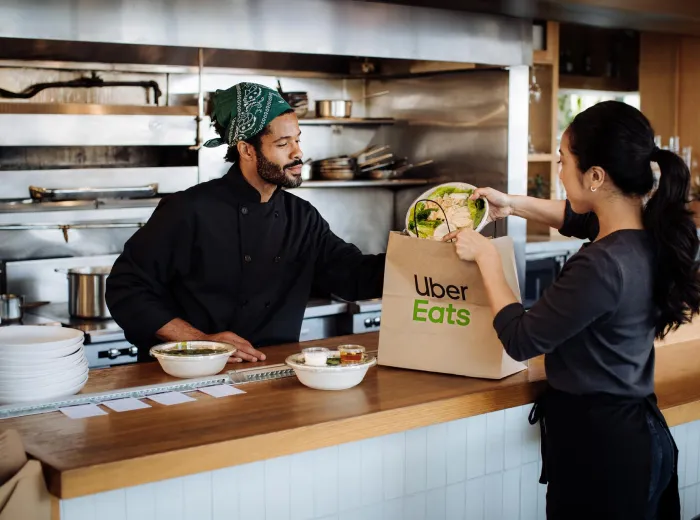

How to Create a Restaurant Marketing Plan? Step-by-Step Guide
Creating a marketing plan is one of the most crucial steps to ensuring the long-term success of your restaurant. In today’s competitive food and beverage industry, relying solely on word-of-mouth or walk-ins is no longer sufficient. A well-structured marketing plan not only helps attract new customers but also keeps your regulars coming back for more.
Whether you’re running a cozy café, a bustling bistro, or a fine dining establishment, your marketing efforts must align with your goals, target audience, and budget. By focusing on both digital and traditional strategies, you can build a strong presence in your local community while also reaching customers online. This comprehensive guide will help you craft a marketing plan that drives sales, boosts brand recognition, and ensures sustainable growth.
Let’s dive into the essentials of creating a restaurant marketing plan that works for your business. From market analysis to actionable strategies, you’ll have all the tools you need to stand out in the crowd.
What Is a Restaurant Marketing Plan?
A restaurant marketing plan is a roadmap for promoting your restaurant, attracting customers, and achieving business goals. It outlines your strategies, target audience, budget, and specific marketing activities. Without a marketing plan, your efforts may lack direction, wasting time and money. A solid plan ensures all marketing actions are purposeful, measurable, and aligned with your overall objectives.
Definition and Importance of a Marketing Plan
A restaurant marketing plan serves as a strategic document that guides how you promote your restaurant. It defines your goals, the steps to achieve them, and the tools you’ll use.
Key reasons why a marketing plan is essential:
- Focus and clarity: It provides a clear framework for your marketing efforts.
- Resource allocation: Ensures your time, money, and energy are spent on impactful strategies.
- Measurable success: Allows you to track progress and adjust strategies for better results.
By having a detailed marketing plan, restaurant owners can compete effectively in a crowded industry, reaching the right audience at the right time.
Key Components of a Marketing Plan
A comprehensive marketing plan typically includes several critical elements that align with your restaurant’s goals. These components work together to ensure your marketing efforts are targeted and effective.
Core components include:
- Goals and objectives: Define what you want to achieve, such as increased foot traffic, online engagement, or revenue growth.
- Target audience: Understand who your customers are, including their demographics, preferences, and dining habits.
- Budget allocation: Establish how much you can spend and prioritize spending across various marketing channels.
By integrating these components into your plan, you create a cohesive strategy that resonates with your audience and delivers measurable results.
Conduct a Market Analysis for Your Restaurant
Conducting a thorough market analysis is a foundational step in creating a successful restaurant marketing plan. By understanding your market, identifying your competition, and defining your target audience, you can make informed decisions to position your restaurant effectively. This section guides you through the essential steps of analyzing your market for optimal results.
Assess Your Local Market
Understanding your local market is crucial for determining your restaurant’s competitive advantage. A detailed analysis will help you identify market gaps, customer preferences, and potential challenges.
Steps to assess your local market:
- Research competitors: Identify nearby restaurants offering similar cuisines or services.
- Analyze customer demand: Understand what your target audience is looking for in terms of menu, ambiance, and price.
- Evaluate location factors: Consider foot traffic, accessibility, and nearby attractions that might impact your restaurant’s appeal.
By assessing your local market, you can uncover opportunities to differentiate your restaurant and cater to unmet customer needs.
Define Your Target Audience
Clearly defining your target audience allows you to create marketing strategies that resonate with potential customers. Knowing who you’re serving is vital for everything from menu design to promotional campaigns.
How to define your target audience:
- Segment demographics: Identify age, gender, income levels, and lifestyle preferences.
- Create customer personas: Develop profiles representing your ideal customers to guide marketing efforts.
- Analyze customer behavior: Understand dining habits, such as preferred meal times, spending patterns, and loyalty factors.
A well-defined target audience helps you tailor your marketing messages and attract the customers most likely to enjoy your restaurant.
Analyze Industry Trends
Keeping up with industry trends helps you adapt your restaurant’s offerings to meet current and emerging customer demands. Trends influence what customers expect and can provide opportunities to innovate.
Key areas to analyze:
- Dining trends: Monitor preferences for healthy, sustainable, or unique dining experiences.
- Technology adoption: Understand the impact of online ordering, delivery apps, and digital menus.
- Economic factors: Evaluate how inflation, income levels, or other economic variables affect customer spending.
Staying informed about industry trends ensures your restaurant remains relevant, competitive, and attractive to modern diners.
Set Clear Goals and Objectives
Setting clear goals and objectives is a critical part of your restaurant marketing plan. Well-defined goals provide direction, motivation, and measurable benchmarks for success. Whether you aim to increase foot traffic, improve online engagement, or grow revenue, your objectives must be actionable and aligned with your overall business strategy.
SMART Goals for Restaurant Marketing
Using the SMART framework ensures your goals are clear, achievable, and focused. SMART stands for Specific, Measurable, Achievable, Relevant, and Time-bound.
Examples of SMART goals:
- Increase online reservations: Boost website reservations by 20% within three months.
- Improve social media engagement: Gain 500 new Instagram followers and achieve a 10% increase in engagement within six weeks.
- Grow email subscribers: Add 1,000 new subscribers to your restaurant’s newsletter in the next quarter.
SMART goals help you prioritize your efforts and track progress effectively, ensuring that every marketing action contributes to tangible outcomes.
Short-Term vs. Long-Term Objectives
Balancing short-term and long-term objectives ensures that your restaurant can address immediate needs while building for sustained growth.
Examples of short-term objectives:
- Launch a seasonal menu promotion to boost sales during a slow period.
- Increase daily foot traffic by offering a limited-time lunch discount.
Examples of long-term objectives:
- Build a loyal customer base through a rewards program.
- Establish a strong online presence with a well-optimized website and active social media channels.
By defining both types of objectives, you create a strategic approach that addresses current challenges while positioning your restaurant for future success.
Budgeting for Your Marketing Efforts
Allocating a proper budget is essential for executing your restaurant marketing plan effectively. A well-thought-out budget helps prioritize spending, ensures funds are directed toward high-impact strategies, and prevents overspending. With careful planning, you can achieve your marketing goals without compromising your financial stability.
Determine Your Marketing Budget
Determining your marketing budget starts with evaluating your overall financial resources and setting realistic limits. Many experts recommend allocating 3-10% of your revenue to marketing, depending on your restaurant’s size and growth stage.
Factors to consider when setting your budget:
- Current revenue: Base your budget on what you can realistically afford.
- Business goals: Higher goals, such as expansion or rebranding, may require a larger investment.
- Market conditions: Competitive areas often demand more aggressive and costly marketing strategies.
By determining a suitable budget, you can create a plan that maximizes your return on investment without stretching your finances thin.
Allocate Funds Across Channels
Once your budget is established, it’s essential to distribute funds across marketing channels strategically. Diversifying your spending ensures that you reach your audience through multiple touchpoints.
How to allocate your budget effectively:
- Digital marketing (50-70%):
- Website development and SEO
- Social media advertising and content creation
- Google Ads and email campaigns
- Traditional marketing (20-30%):
- Flyers, posters, and print ads
- Local sponsorships or community events
- Innovative strategies (10-20%):
- Collaborating with influencers or bloggers
- Experiential marketing, such as pop-up events or in-store promotions
By tracking the performance of each channel, you can reallocate funds to the strategies that deliver the best results. This ensures your marketing budget works harder for your restaurant’s success.
Develop Your Marketing Strategies
Developing effective marketing strategies is the core of your restaurant marketing plan. These strategies should align with your goals, resonate with your target audience, and utilize both digital and traditional methods. A balanced approach helps maximize your reach while creating a strong brand identity.
Build an Online Presence
A robust online presence is essential for attracting and retaining customers. Your restaurant’s website and social media profiles serve as digital storefronts that make a lasting impression.
Key elements of an effective online presence:
- Website essentials:
- User-friendly design with clear navigation
- Mobile optimization for easy access on smartphones
- SEO strategies to rank high in search engine results
- Online reservations and menu accessibility
- Social media strategies:
- Regularly posting engaging content, such as food photos, behind-the-scenes videos, or promotions
- Interacting with followers through comments, direct messages, and polls
- Utilizing platforms like Instagram, Facebook, and TikTok based on your audience demographics
A strong online presence increases your visibility and helps convert online traffic into paying customers.
Utilize Digital Marketing
Digital marketing offers cost-effective ways to reach your target audience and track the performance of your campaigns in real time.
Effective digital marketing tactics:
- Email marketing campaigns:
- Build a mailing list through website sign-ups and in-restaurant promotions.
- Share newsletters featuring special offers, events, and seasonal menus.
- Paid advertising:
- Use Google Ads for local search visibility.
- Run targeted ads on social media to reach potential diners based on location, interests, and behavior.
- Online reviews and reputation management:
- Encourage satisfied customers to leave positive reviews on platforms like Yelp and Google.
- Address negative feedback promptly and professionally to maintain your reputation.
Digital marketing ensures your restaurant stays top-of-mind for both existing and potential customers.
Leverage Traditional Marketing
Traditional marketing strategies remain relevant, especially for attracting local customers and building a community presence.
Examples of traditional marketing strategies:
- Distribute flyers and posters in high-traffic areas.
- Partner with local businesses for cross-promotional opportunities.
- Sponsor community events or local sports teams to increase brand visibility.
- Offer in-store promotions, such as discounts for first-time visitors or happy hour deals.
Combining traditional methods with digital marketing creates a comprehensive approach that reaches customers on multiple levels.
Focus on Community Engagement
Engaging with your local community strengthens your restaurant’s brand and fosters loyalty among your customers.
Ways to engage with your community:
- Host events, such as cooking classes, wine tastings, or live music nights.
- Collaborate with local influencers or food bloggers to promote your restaurant.
- Support charitable causes by donating a portion of your sales or participating in fundraisers.
- Offer exclusive promotions to local businesses or residents.
Community engagement not only builds goodwill but also creates word-of-mouth buzz that attracts new customers.
Create a Content Calendar
A content calendar is a powerful tool to organize, schedule, and execute your marketing campaigns effectively. By planning ahead, you can ensure consistent messaging, capitalize on seasonal opportunities, and maintain engagement with your audience across all channels.
Plan and Schedule Your Campaigns
Planning campaigns in advance helps you stay on track and ensures that your marketing efforts align with key dates and trends.
Steps to create a campaign plan:
- Identify important dates:
- National holidays, local events, and seasonal opportunities (e.g., Valentine’s Day, summer specials).
- Restaurant-specific milestones like anniversaries or menu launches.
- Schedule promotions:
- Weekly specials or happy hours.
- Monthly campaigns, such as themed menus or limited-time offers.
- Organize by platform:
- Assign specific content to each channel, such as Instagram posts, email newsletters, or website updates.
A well-planned calendar ensures your campaigns are timely and relevant, increasing the chances of engaging your target audience.
Consistent Messaging Across Platforms
Maintaining consistent messaging across platforms reinforces your brand identity and ensures customers receive a cohesive experience.
Tips for consistent messaging:
- Define your brand voice: Is it casual, elegant, or fun? Your tone should match your restaurant’s style.
- Use uniform visuals: Stick to a consistent color palette, logo placement, and font style in your designs.
- Coordinate content themes: Ensure your social media, emails, and in-store materials align with the same campaigns.
Consistency builds trust and familiarity, making your restaurant more memorable and appealing to customers.
By using a content calendar to organize campaigns and maintain consistency, you create a structured approach that enhances your marketing efforts and ensures your audience stays engaged year-round.
Monitor and Optimize Your Plan
Monitoring and optimizing your marketing plan is an ongoing process that ensures your strategies are delivering the desired results. By analyzing performance data and adjusting your approach, you can maximize your return on investment and continually improve your restaurant’s marketing efforts.
Measure Marketing Performance
Tracking the performance of your marketing campaigns is critical to understanding what works and what doesn’t. With the right tools and metrics, you can identify strengths and address weaknesses.
Key metrics to monitor:
- Sales growth: Track changes in revenue and correlate them with marketing efforts.
- Customer engagement: Measure likes, comments, shares, and click-through rates on social media and email campaigns.
- Website traffic: Monitor visits, bounce rates, and time spent on your site using tools like Google Analytics.
- Conversion rates: Assess how many people take desired actions, such as making reservations or signing up for newsletters.
Regularly reviewing these metrics allows you to evaluate your marketing plan’s effectiveness and make data-driven decisions.
Adjust Strategies Based on Results
Optimization involves refining your strategies to focus on what yields the best outcomes. Marketing is rarely a one-size-fits-all approach, so flexibility is key.
How to optimize your plan:
- Identify underperforming campaigns and experiment with new approaches.
- Reallocate budget to channels that demonstrate the highest ROI.
- Test different content formats, such as videos, stories, or blogs, to see what resonates most with your audience.
By being proactive in making adjustments, you ensure that your marketing plan remains relevant and impactful.
Tools for Marketing Analytics
Leveraging analytics tools can simplify the process of tracking and optimizing your marketing efforts. These tools provide detailed insights and actionable data.
Recommended tools for restaurant marketing analytics:
- Google Analytics: Analyze website traffic and user behavior.
- Social media platforms: Use built-in analytics tools like Instagram Insights or Facebook Analytics.
- Email marketing software: Track open rates, click-through rates, and subscriber growth with platforms like Mailchimp or Constant Contact.
- POS systems: Many modern point-of-sale systems offer customer data and sales trend reports.
Using these tools helps you monitor your campaigns in real-time, identify opportunities for improvement, and maintain a data-driven approach to your restaurant marketing plan.
Actionable Tips for Long-Term Success
To ensure the sustained growth and success of your restaurant, your marketing efforts need to extend beyond short-term campaigns. Implementing long-term strategies builds brand loyalty, adapts to changing trends, and positions your restaurant for enduring profitability. Here are some actionable tips to help you achieve long-term success.
Build Customer Relationships
Strong customer relationships are the foundation of a successful restaurant. Loyal customers not only return frequently but also act as brand ambassadors, sharing positive experiences with others.
Ways to foster customer loyalty:
- Loyalty programs: Offer rewards for repeat visits, such as discounts, free items, or exclusive deals.
- Personalized experiences: Use customer data to create tailored offers and recommendations.
- Encourage feedback: Actively seek reviews and suggestions, then implement changes to show you value their input.
Building strong relationships not only enhances customer satisfaction but also ensures they keep coming back.
Stay Updated on Trends
The restaurant industry is ever-evolving, with new dining trends, technologies, and customer expectations emerging regularly. Staying informed helps you adapt and remain competitive.
How to stay ahead of trends:
- Monitor industry news: Follow blogs, trade publications, and social media influencers in the food and beverage industry.
- Experiment with new ideas: Test small-scale menu additions, promotions, or technologies to see what resonates with your audience.
- Embrace technology: Stay updated with tools like online ordering systems, QR code menus, and digital loyalty programs.
Adapting to trends ensures your restaurant stays relevant and appealing to both new and existing customers.
Invest in Continuous Improvement
Consistently evaluating and improving your restaurant’s operations and marketing ensures you’re always ahead of the curve.
Areas to focus on for improvement:
- Menu innovation: Regularly refresh your menu with seasonal ingredients and trending dishes.
- Staff training: Equip your team with the skills needed to deliver exceptional service and promote your restaurant effectively.
- Customer experience: Continuously refine your ambiance, service speed, and overall dining experience.
By committing to improvement, you not only keep your customers excited but also strengthen your restaurant’s position in the market.
These actionable tips provide a roadmap for sustaining long-term success, helping you build a thriving restaurant that grows stronger with time.
Key Takeaways
Creating a restaurant marketing plan requires careful planning, consistent execution, and a willingness to adapt. By following the steps outlined in this guide, you can develop a strategy that drives results and positions your restaurant for lasting success.
Here are the key points to remember:
- A restaurant marketing plan is your roadmap to achieving your business goals through targeted promotions and strategies.
- Conducting a market analysis helps you understand your competition, identify opportunities, and define your target audience.
- Setting clear goals and objectives ensures your efforts are focused, measurable, and aligned with your business vision.
- Allocating a proper marketing budget and diversifying spending across digital and traditional channels maximizes your ROI.
- Building an online presence and leveraging digital marketing tools like email campaigns, social media ads, and SEO are essential in today’s market.
- Engaging with your local community through events, partnerships, and sponsorships strengthens your brand identity.
- Using a content calendar keeps your campaigns organized, timely, and consistent across all platforms.
- Regularly monitoring and optimizing your strategies based on performance metrics ensures continuous improvement.
- Focusing on long-term success through customer relationship building, trend adoption, and continuous improvement sustains growth.
By implementing these practices, you can create a marketing plan that not only drives traffic and sales but also builds a loyal customer base, ensuring your restaurant thrives in a competitive landscape.
ABOUT THE AUTHOR
Erkin Coban
Your Customers Deserve The Best
And we got Menuviel for them.
The fastest and easy-to-use online QR menu with 12+ unique features. Choose Menuviel and elevate your service quality to the next level.
Use free for the first 30 days.

In This Article

Free AI Tools for Restaurants
TRY NOW ➜

Manage what’s available - anytime, instantly
Show or hide menus, categories, or items instantly. Perfect for time-based offerings or sold-out dishes.





